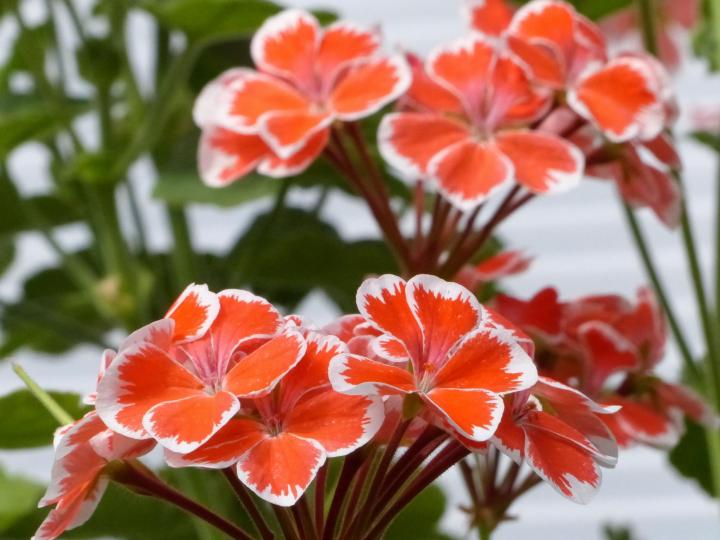
Planting, Growing, and Caring for Geraniums
The Almanac Garden Planner - Use It Free for 7 Days!
Plan your 2025 garden with our award-winning Garden Planner.
Types
- Interspecific: zonal and ivy hybrids; nonstop flower producers
- Ivy (Pelargonium peltatum): named for a trailing habit and ivy-like foliage; single, semidouble, or double flowers; colors include bicolor, burgundy, pink, purple, red, salmon, and white. Very popular for hanging baskets, window boxes, and containers.
- Regal, aka ‘Martha Washington’ (P. x domesticum): bicolor burgundy, lavender, pink, and white blooms; fussy—prefers cool, wet, climate conditions to hot, humid, and/or sunny; inappropriate conditions will reduce flower production; often a houseplant
- Scented: foliage yields scent (cedar, lemon, lime, mint, orange, and rose) when brushed or rubbed; note that ‘Citronella’ does not repel mosquitoes; pink or white flowers are smaller than those of zonals. It can be addictive to collect them all. Learn more about scented geraniums.
- Seed: similar to zonals; propagated by seeds; slower-growing, shorter, more compact than zonals; smaller but more numerous flowers than zonals; flowers “shatter” (are shed naturally)
- Variegated: a form of zonal; bi- or tricolor foliage; tends to have fewer flowers than other zonal types
- Zonal (P. x hortorum): the most common form; “zonal” refers to patterns on the leaves that darken with maturity; propagated by cuttings; single or double flowers; colors include bicolor, orange, purple, red, salmon, and white. These thrive in containers (as well as outdoors).
ADVERTISEMENT
I have been growing geranium in pots for years, cutting way back and bringing indoors in the fall. This year, they were beautiful through July. Now, something is eating lacy holes on leaves and buds dying on some, and yellowing leaves on others. I don’t see any bugs or caterpillars on the leaves. What to use to spray? Can I still overwinter?
Hi Carol,
It sounds like there could be a number of pest or disease issues going on with your geraniums, and it could be more than one thing based off the symptoms you listed. While it is great that you have been bringing them in each fall for the winter, it might be time to consider getting new plants at this point considering what has happened this year.
If you truly want to save these specific plants, you could try cutting them all the way back and repotting in new potting mix, removing as much of the old mix as possible in an effort to avoid bringing anything indoors for the winter. You will still run the risk of introducing a disease or pest into your home, and if you have a lot of other plants indoors, it might not be the best idea.
I have never had this problem before with my geraniums. The leaves are turning brown around the outer edges. They are healthy plants and are blooming wonderfully, but I'm concerned about the browning on the outer edges of the leaves. I've never had a problem with over watering them.. They are sitting in pots on my front porch--- the same warm sunny spot they were in last year. Can you tell me what the problem might be?
Thank you!
Hi, Susan. We wonder if you are in any of the areas of the country that are experiencing record high heat at the moment. Geraniums will suffer, and leaves may turn brown, when the heat gets to be too much for them. If the browning is mostly on the lower leaves, this could mean a bacterial disease. The brown leaves could also be from over-fertilizing.
How can I keep the squirrels from digging in my geraniums?
Shoot them or sprinkle hot pepper around the plant
Seriously shoot them? Wow!!! Instead I put rounded rocks around them in my pots. It keeps them from digging in as the squirrels just want to bury their food. Also I make decorative chicken wire cages over all my pots to keep them out. I feed mine which keeps them out of the bird feeders. They have more rights to live here then any of us! Without squirrels we wouldn't have the diverse forest we do. Who do you think has been planting them for centuries!
I use garlic powder. You can buy a large bag (5 Lbs?) from Amazon. It is cheaper in bulk, a lot better than those little bottles you buy for the kitchen. Squirrels do not like the smell. I can't shoot them because they seldom come above ground until the weather warms. They eat the roots of my plants, mostly Hollyhocks. I have desert ground squirrels (I think) that are about the size of a chipmunk. They could be gophers the way they tunnel everywhere, even in the hard desert soil between my raised beds.
Donna-
Squirrels can be such a pest! Check out this link for ideas to keep the squirrel population at bay.
20 gallon pot!!!! That's about the size of garbage can. Even 20 L is large for geranium.











